Biochemistry and Molecular Biology – Flashcards
Unlock all answers in this set
Unlock answersquestion
What do antibiotics inhibit?
answer
Bacterial translation in Eukaryotes, not affecting Eukaryotic RNA and protein function.
question
How is translation terminated?
answer
Stop codon, and Release factor that cause peptidyl transferase to catalyze a water molecule to the carboxyl end of the last amino acid
question
List the stop codons.
answer
UAA, UGA, UAG
question
Define an ORF.
answer
Open Reading Frame: series of codons starting with ATG and ending with a stop codon. Doesn't necessarily code a protein but possible.
question
Key features of a plasmid that allow it to be cloned:
answer
1. One of more useful restriction sites at which YFG can be inserted 2. Selectable marker that allows the identification of the plasid in bacteria 3. Orgin of replication to allow replication of plasmid, independently of host chromosome
question
What are the most common selectable markers for use in bacteria?
answer
Genes encoding resistance to antibiotics. These include resistance to ampicillin, tetratcycline, kanamycin and chloraphenicol.
question
What are the four steps of PCR?
answer
1. Denature DNA at 90-95°C 2. Anneal two primers ar 50-60°C 3. Extend the primers with a DNA polymerase and the 4 dNTPs at 72°C 4. Repeat steps 1-3 about 30 times
question
What is the number of molecules of YFG after n cycles of PCR?
answer
2ⁿ For example, after round 2 you would have 2² copies of YFG.
question
Which two technical advances have made PCR a general tool?
answer
Thermostable polymerases such as Taq polymerase and automated thermocyclers.
question
How do you seperate the different DNA fragments you got as a result of PCR?
answer
Seperate by size. Use gel electrophoresis in which DNA molecules can sieve through agarose/polyarcylamide. Small DNA molecules can sieve through pores in gel more easily, thus small DNA molecules will be able to sieve towards the positive end of the magnetic field faster.
question
Two routine methods for visualizing DNA on the gel in gel electrophoresis.
answer
Ethidium bromide between bases which will fluoresce red in UV light. ³²P to 5' ends of DNA fragment using gamma ³²P-ATP.
question
When using mRNA as the template _______ is often used as the primer for the synthesis of the cDNA as it will anneal to the polyA tail.
answer
poly-dT
question
Define Tm.
answer
Tm is the temperature at which 1/2 of a specific double stranded DNA has become single stranded.
question
Which can influence Tm?
answer
AT/GC content: The more GC content, the higher the Tm because 2 hydrogen bonds versus 3. Length of helix: Shorter molecules melt at lower temperatures. Salt content: Higher salt increases Tm becuase salt neutralizes the negative charge in the phosphate backbone. Solvent: Formamide and urea decrease Tm by weakening hydrogen bonds. Imperfect matching in DNA: Decreases Tm.
question
ssDNA can anneal with ____ and ____. RNA can anneal with ___.
answer
ssDNA, RNA. RNA.
question
Steps in a Northern Blot
answer
1. Isolate RNA from different tissues 2. Use gel electrophoresis to seperate RNA based on size 3. Transfer seperated RNA to a membrane (nitrocellulose/nylon) 4. Prepare radiolabeled single stranded complementary probe for fragment of interest 5. Incubate the probe with the filter at about 10°C below the Tm 6. Wash away any nonspecifically bound probe 7. Expose probed filter to X-ray film
question
When would you want to use Northern Blot?
answer
When you have a gene/RNA and you want to find out where it is expressed in other cell types or if it is expressed in other cell types. You probe DNA with RNA in Northern blots.
question
Restriction enzymes are Type ___ enzymes. Which show specific ____ and specific _____ of DNA.
answer
II, recognition, cleavage
question
What is a palindromic sequence?
answer
A sequence that reads the same both ways.
question
When can you have sticky ends and when can you not?

answer
5' overhang and 3' overhangs result in sticky eneds that can base pair and reanneal. Blunt ends cannot base pair and reanneal and thus do not have sticky ends.
question
The DNA ligase enzyme is usually isolated from what?
answer
T4 bactriophage
question
Do DNA ligase require energy to reseal compatible sticky ends?
answer
Yes, given a 5' phosphate DNA ligase will reseal compatible sticky ends using ATP.
question
Can DNA ligase reseal blunt ends?
answer
Yes, but less efficently.
question
What are some difficulties assosciated with expression of eukaryotic proteins in bacteria?
answer
-Incorrect folding possibility -Lack of post-translational modification (phorsphorylation, glycosylation) -Poor Stability
question
What is glycosylation?
answer
Post-translational modification through the attachment of sugars to proteins.
question
Why is site directed mutagenesis used?
answer
To produce proteins that have improved or special qualities becuase the gene that was used to produce them was mutated. Also used to create a protein that has lost its function because of an altered gene sequence.
question
State the steps of site directed mutagenesis.
answer
1. Oligonucleotide with desired mutation will anneal with single stranded template at the position to be altered 2. dNTPs and DNA polymerase extend the oligonucleotide forming a second strand 3. DNA ligase will seal the nick and the result will be a double stranded template **Can then use PCR to amplify DNA to allow for cloning**
question
What are DNA microarrays and when do you use them?
answer
DNA microarrays are a way of analyzing thousands of genes at a time. The standard use of microarrays is to find out what genes are expressed in a cell under certain conditions.
question
How do you use DNA microarrays?
answer
Two conditions, two cDNA probes per condition. One tagged with red fluor and other with green fluor. The two fluorescent probes are hybridized to an array with DNA with all or many ORFs in a cell type and detected by a laser microscope. Red spots indicate genes that are only expressed in condition X, Green spots indicate genes that are only expressed in condition Y and Yellow spots indicate genes that are expressed in both conditions.
question
What is RNA profiling?
answer
cDNAs produced randomly from cell tissue and sequenced. The number of reads of the sequence is proportional to the level at which it is expressed at that random time.
question
How are Short Tandem Repeats used for DNA fingerprinting?
answer
STRs vary in individuals. To fingerprint an individual you use primers around the STRS and then amplify the STR by PCR. Then you can use gel electrophoresis to analyze becuase different STRs will run at different positions on the gel.
question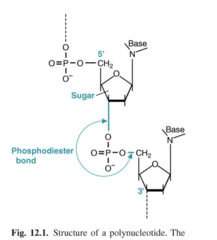
What linkage is formed between sugars in DNA and which carbons are involved in the bond?

answer
Phosphodiester linkages; from the 5'carbon to the 3' carbon
question
What is the significant difference between the sugar in DNA and RNA?
answer
DNA does not contain an Oxygen atom on the 2' carbon hence the term "deoxy-"
question
Whats the difference between purines and pyrimidines?
answer
Purines consist of two rings fused together whereas pyrimidines are only one ring
question
What tautomer of the nitrogenous bases is most prominent in solution?
answer
Keto form; more stable *keto form and enol form have different hydrogen bonding capabilities thus one is favoured over the other*
question
Which one of the following statements regarding the DNA double helix structure is FALSE? a) the structure is antiparallel (5' of one strand adjacent to 3' strand of the other) b) the helix is left handed c) the sugar backbone is on the outside, and the
answer
B) the helix is RIGHT handed
question
Why is the sugar backbone found on the outside of the structure?
answer
Phosphates of sugar backbone have a negative charge, and thus by facing outwards the negative charge is spread out
question
How many hydrogen bonds for between A-T? G-C?
answer
2 for A:T 3 for G:C
question
How thick is a DNA strand?
answer
2 nm
question
What is the distance between base pairs?
answer
0.34 nm
question
How many base pairs in one complete turn of DNA?
answer
10
question
Why is there a minor and major groove on the the DNA helix?
answer
Bases are not symmetrically oriented relative to the backbone.
question
In alkaline solution is DNA more stable or is RNA?
answer
DNA; RNA tends to degrade in alkali solution becuase of it's 2'-OH group that interacts with the base.
question
What is the main difference between the structure of Uracil and Thymine?
answer
Thymine has a methyl group at where a uracil has a hydrogen. Otherwise, rest of the structure is the same.
question
True or False: RNA is usually longer than DNA
answer
False, DNA is longer.
question
True or False: RNA and DNA are both sequence dependent structures
answer
False, DNA is not sequence dependent as it is always a double helix.
question
True or False: DNA is less likely to have its nitrogenous bases modified in comparison to RNA
answer
True, RNA is more likely to be modified.
question
True or False: RNA can exist as single stranded or double stranded.
answer
False, RNA is single stranded yet it can from intramolecular bonds with itself to form unique structures.
question
What is "chromatin"?
answer
Complex of DNA and its organzing proteins.
question
What are "histones"?
answer
Histones are proteins that make up chromatin, they are used to condense DNA.
question
Which of the following statements about histones are FALSE? a) composed of positively charged lysine and arginine residues b) each histone is composed of fewer than 200 amino acids c) found in prokaryotes and eukaryotes d) all of the above are true
answer
C, histones are only found in eukaryotes!
question
What does it mean when the sequence for a histone is "conserved"?
answer
The sequence for histones are very similar in various organisms indicating that the histone have been evolutionarily conserved. Also, that histones are very important since they have been conserved over evolutionary time.
question
What is an "octamer"?
answer
Consists of 4 histone proteins (H2A, H2B, H3, H4) to make a DNA packaging complex. Two of each histone proteins make up histone octamer(8).
question
How many times does a DNA wrap around an octamer?
answer
1.7 times (147 bases)
question
Which histone is not found in an octamer?
answer
H1, it is instead used for adjacent linking of nucleosomes.
question
What is a "nucleosome care particle"?
answer
Histone octamer and DNA wrapped around it.
question
What is a "nucleosome"?
answer
Nucleosome core particle plus adjacent linker DNA to next nucleosome. Linkers can be 3-80 bp long.
question
By what factor do nucleosomes compact DNA? a) 3x b) 5x c)10x
answer
3x
question
Approximately how many base pairs can be found withing one nucleosome?
answer
200 base pairs!
question
What structure do nucleocomes fold into?
answer
30 nm chromatin fibres
question
What histone stabilizes the 30 nm chromatin fibres?
answer
H1
question
What vague structure do 30 nm chromatin fibres fold into? How many base pairs are found in each structure?
answer
Loops, 30-200 kbp in one loop.
question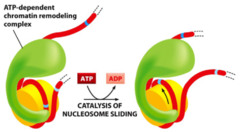
What complex allows DNA to decompact for reading?

answer
Chromatin Remodeling Complex/ Chromosome Remodelling Complex
question
Given a nucleotide sequence 5' - ATGTACCTG - 3', what is the complementary strand? a) AGTTCGTGC b) ATGTACCTG c) TACATGGAC d) CAGGTACAT
answer
D: 3'-CAGGTACAT-5'
question
What is a "chromosomal scaffold"?
answer
System of non-histone proteins that support the 30 nm chromation loops structure (3rd level of folding).
question
True or False: Chromosomal remodelling complexes require ATP to unfold DNA
answer
True, Chromatin Remodelling Complexes require ATP
question
What is a poorly understood factor related to histone structure/folding?
answer
Histone chemical modification that can involve methylation, phosphorylation, acetylation
question
Which of the following is the CORRECT order of DNA replication steps? a) initiation → priming → DNA synthesis → proofreading → ligation b) priming → initiation → proofreading → DNA synthesis → ligation c) ligation → initiation → priming → DNA synthesis → DNA cleavage d) initiation → priming →proofreading → DNA synthesis → ligation
answer
A, initiation → priming → DNA synthesis → proofreading → ligation
question
Where does initiation occur?
answer
At the replication origin. A richness in TA base pairs indicates an initiation site. Single replication origin found in prokaryotes, but multiple replications through prokaryote genome.
question
What protein is responsible for unwinding the DNA double helix?
answer
DNA Helicase
question
What did Meselson and Stahl discover about DNA replication and what was their theory called?
answer
Semi-conservative theory - upon replication each new daughter strand consists of a parent strand and a newly synthesized strand.
question
What is the function of "inititaion proteins"?
answer
To recognize replication origins and pull apart the two strands.
question
What base pairs are most common in the replication orgin and why?
answer
TA base pairs because they are relatively weaker then CG base pairs which share 3 hydrogen bonds.
question
Which binds to the replication origin first, the initiator proteins or DNA Helicase?
answer
Initaior proteins
question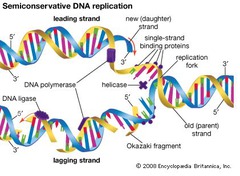
What does DNA Helicase require to unwind the DNA?

answer
ATP
question
What prevents the two DNA strands separated by DNA Helicase from reannealing?
answer
Single stranded binding proteins help hold the two strands apart.
question
True or False: Following the unwinding of DNA, DNA Polymerase binds to each template strand and begins the synthesis of a new strand.
answer
False, DNA polymerase cannot begin replication without primers
question
What is the function of "primase"?
answer
To lay down primers (~10 nucleotides) on the DNA strand which will be extended 5'-3' from their 3' end by DNA polymerase. The primers provide DNA polymerase with a starting pointing.
question
In which direction does DNA Polymerase synthesize the new strand onto the template strand?
answer
5'-3' on the NEW strand. (But, 3'-5' relative to the template strand.)
question
What protein is responsible for keeping DNA polymerase on the template strand?
answer
Sliding Clamp Protein
question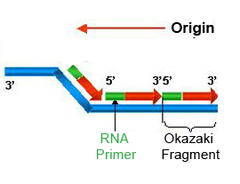
What are "Okazaki fragments" and where are they found?

answer
Okazaki fragments occur on the lagging strand becuase DNA synthesis occurs in a discontinuous manner on the lagging strand.
question
True or False: The lagging strand requires multiple primers, whereas the leading strand generally requires only one
answer
True, the lagging strand synthesizes discontinuously and thus it requires many primers for the start of each Okazaki fragment
question
What nitrogenous bases are pyrimidines?
answer
Cytosine, Thymine, Uracil
question
True or False: The leading strand is synthesized first, and the lagging strand is synthesized second
answer
False, both are synthesized concurrently
question
What protein connects Okazaki fragments together?
answer
DNA ligase
question
True or False: Many replication bubbles form along a DNA strand during replication
answer
True (in eukaryotes)
question
True or False: Primers in DNA replication are composed of RNA.
answer
True
question
What binds to the newly synthesized DNA strand once DNA Polymerase encounters an RNA primer and exits replication?
answer
Another DNA polymerse (DNA polymerase I)
question
What is 5'-3' exonuclease activity?
answer
It is when DNA polymerase proofreads as it is synthesizing, looking for and removing errors such as deletion, insertion or substitution.
question
How often do DNA replication errors occur in humans?
answer
once every 10⁷ bases
question
True or False: DNA synthesis and 5' to 3' exonuclease activity occur at different active sites on DNA polymerase
answer
True
question
Apart from proofreading, what other function does 5' to 3' exonuclease activity have?
answer
Removal of RNA primers that were formed at the start of replication as the new DNA is being synthesized.
question
What two things does DNA ligase require to connect DNA fragments into one strand?
answer
ATP (humans) and NAD+(prokaryotes) A 5' phosphate group and 3' OH group
question
What product is formed when DNA Ligase hydrolyzes ATP?
answer
AMP (adenosine monophosphate)
question
What is the function of tRNA?
answer
To carry amino acids to the ribosome allowing for translation
question
What is the difference in function between DNA Polymerase III and DNA Polymerase I?
answer
DNA polymerase III synthesizes new DNA until it hits the next RNA primer where it disasssociates. DNA polymerase I comes in and removes the RNA primer, synthesizing DNA in its place.
question
What are telomeres composed of?
answer
Proteins and DNA that contains many repeats.
question
Approximately how long is a telomere?
answer
5 000-15 000 bp
question
True or False: The 5' end of a telomere hangs off and invades the DNA earlier in the telomere sequence
answer
False, it is the 3' end of the telomere that hangs off and invades.
question
How long is the overhang of a telomere?
answer
30-200 bp
question
Why do telomeres contain many repeats?
answer
Allows for the 3' overhang to form a loop with a earlier segment in the telomere. Also, as chromosomes divide DNA is lost at the ends of the chromosome. Telomeres act as buffers at the end of chromosomes to provide safety to the chromosome such that when it divides no critical information is lost, only repeat sequences are lost.
question
True or False: Telomeres contain gene sequencing DNA.
answer
False
question
State the two purposes of telomeres.
answer
1. Allow chromosomes to distinguish between a natural true end of a chromosome versus a double stranded break 2. Provide extra length at the ends to prevent gene coding DNA from being lost due to inabailty to synthesize DNA to the very end at the lagging strand
question
Can the lagging strand be synthesized to the chromosome tip? If not, why not?
answer
No, it cannot becuase the final RNA primer doesn't go to the very end of the lagging strand.
question
What protein is responsible for the synthesis of telomeres? Does this protein extend the template strand or new strand?

answer
Telomerase extends the template strand on the lagging strand, and then an RNA primer is added again to the template lagging strand and DNA polymerase synthesizes the rest of the complementary strand. http://faculty.plattsburgh.edu/donald.slish/Telomerase.html
question
True or False: Telomerase expression in somatic cells stops shortly after birth.
answer
True
question
How does the expression of telomerase relate to cancer cells?
answer
Telomerase is continuously expressed in cancer cells, preventing them from dying becuase of lost genetic information.
question
How does AZT combat HIV?
answer
AZT mimicks a sugar that would be incorporated into the viral DNA, however the "AZT sugar" does not contain a 3'-OH preventing the viral DNA from being able to elongate.
question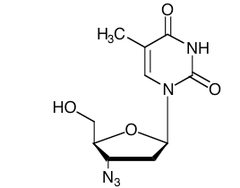
What group is found on the 3' carbon in AZT instead of a hydroxyl group of a normal sugar?

answer
An azide group: N₃
question
True or False: Viral polymerase incorporates AZT into DNA, whereas human polymerase does not.
answer
False, human polymerase does incorporate AZT into DNA but just very infrequently. This is the reason that causes people taking AZT to feel sick.
question
What "copying mistakes" can occur in DNA?
answer
Deletion, insertion, substitution
question
What is depurination and when does it occur? What impact does depurination have on DNA replication?
answer
Spontaneuous loss of a G or A. This usually promoted by acid. When a base is lost, DNA replication is stalled since theDNA polymerase doesn't what tp do when a base is missing.
question
What results when depurination remains unrepaired?
answer
Deletion in the daugher double strand where the G/A was found.
question
How can replication continue past the site of depurination?
answer
When DNA polymerase falls off becuase it was stalled, Translesion DNA polymerase comes in and either inserts a random base in the place of G/A or it skips the missing base and replicates past the site of damage. Translesion DNA polymerase works on a few sites but then the original DNA polymerase comes back and continues replication because the error-prone Translesion DNA Polymerase is too risky.
question
What is deamination?

answer
Deamination is when a amine group spontaneously converts into a carbonyl. This most commonly happens to cytosine, converting the cytosine into a uracil.
question
What is the result of unrepaired cytosine deamination?
answer
The U links with an A in the mutated daughter double strand. The G that original C was bonded to turns into a A in the mutate daughter double strand. Eventually you end up with a T linked to a A in the double strand.
question
What are Pyrimidine Dimers?
answer
Formation of a cyclobutane ring between two adjacent pyrimidines becuase of exposure to UV light. Most frequently, thymine dimers are the result. Dimers block replication.
question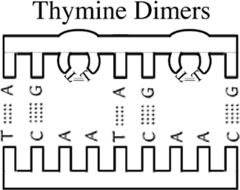
How can replication continue past the site of thymine dimers?

answer
Translesion DNA polymerase can overcome the block by synthesizing DNA past the site of mutation or incorporating a mutation in the place of the dimer.
question
What can result in breakage of sugar-phosphate backbones or chemical changes in bases?
answer
Radiation, Chemical mutagens (O₂⁻ superoxide radical), mechanical stress
question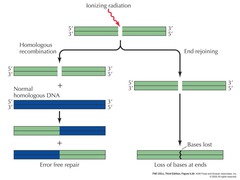
What can be the result of double strand breaks?

answer
Chromosome abnormalities or cell death.
question
How is the newly synthesized strand of DNA identified in bacteria?
answer
Bacteria add methyl groups to their bases in the DNA over time, so a newly synthesized strand would not have methyl groups on bases.
question
How are mismatch errors corrected in bacteria?
answer
- Endonuclease nicks backbone where mismatch is - Exonuclease goes in and removes the error - DNA polymerase goes in and fills in the removed DNA correctly
question
How is the newly synthesized strand of DNA identified in eukaryotes?
answer
The newly synthesized strand in eukaryotes tends to have nicks in the sugar phosphate backbone. Origin unknown but a proposed theory is that DNA polymerase sometimes adds in RNA while synthesizing which are removed, resulting in nicks.
question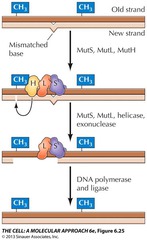
How are mismatch errors repaired in eukaryotes?

answer
- mismatch repair proteins look for nicks in the newly synthesized strand - Exonuclease degrades the newly synthesized strand from the point of the nick to the point of the mismatch - DNA polyermase and DNA ligase come in and resynthesize using other strand as template
question
Mismatch repair only fixes mistakes made by DNA _________.
answer
Polymerase!
question
What errors are fixed by Base Excision Repair (BER)?
answer
Localized, small types of damage such as modified bases, abasic sites and single stranded breaks.
question
What are the 5 steps of BER?
answer
1. Base excision by exonuclease 2. Endonuclease makes a nick in the sugar phosphate backbone to indicate to DNA polymerase the right position for synthesis 3. DNA polymerase adds the correct base, resulting in a overhanging sugar phosphate backbone 4. The extended sugar phosphate backbone is gotten rid of by endonuclease 5. DNA ligase comes in and seals the nick in the backbone.
question
What is the difference between short patch BER and long patch BER?
answer
Short patch BER only excises 1 nucleotides whereas long patch BER can excise 2-10 nucelotides.
question
What errors are fixed by Nucleotide excision repair?
answer
Major damages such as large chemical damage to the DNA double helix resulting in DNA damage that is broader than a single base. ex. repair of thymine dimers that disrupts double helix
question
What are the four steps of NER?
answer
1. Endonuclease nicks the backbone at either side of damaged section (10-30 bp apart) 2. DNA helicase removes the damaged section 3. DNA polymerase resynthesizes removes section 4. DNA ligase seals the sugar phosphate backbone
question
What two methods of DNA repair fix double stranded breaks?
answer
Homologous and Nonhomologous recombination.
question
What is the process of homologous recombination?
answer
Damaged DNA molecule matches up with an undamaged DNA molecule to ensure accurate repair using undamaged DNA as template.
question
What is the process of nonhomologous recombination?
answer
DNA ligase quickly joins the two broken ends of the double strand break regardless if information is loss.
question
What is the key difference between homologous and nonhomologous recombination?
answer
Loss of information.
question
When does homologous recombination occur more frequently than nonhomologous?
answer
In organisms with smaller genomes since homologous recombination is a slow process requires easy acces to undamaged DNA molecule. Homologous recombination tends to occur shortly after replication since it requires a template double strand to match to.
question
What are the three reasons why DNA is transcribed into RNA?
answer
1. Allows for gene amplification 2. Can be easily degraded providing mechanims to turn genes off 3. Provides additional oppurtunities for modification
question
How many protein encoding genes are found in a human cell?
answer
About 21 000 different protein encoding genes.
question
How many points of gene regulation exist in a eukaryotic cell?
answer
7
question
Which of the following is NOT a method of gene regulation during transcription? a) making RNA at different quantities b) phosphorylating/acetylating the RNA strand c) terminating transcription of RNA at different points d) elongating the RNA at different speeds
answer
B, phosphorylating/acetylating is done during protein processing
question
How are genes regulated during RNA processing?
answer
- 5' 7-methylguanosine capping - 3' polyadenylation - RNA splicing - RNA editing
question
True or False: RNA processing occurs within and outside the nucleus.
answer
False, RNA processing occurs only before the RNA is transported outside of the nucleus into the cytoplasm of the cell.
question
How are genes regulated during mRNA export?
answer
Proteins in the nuclear pores highly regulate what mRNAs can leave the cell. They must have 5' 7-methylguanosine cap, 3' polyA tail, cap-binding protein, polyA binding protein and exon junction complex to exit the cell.
question
True or False: mRNA degradation in the cytoplasm of the cell occurs randomly and is controlled by the amount of copies of the same RNA strand produced
answer
False, mRNA degradation is a higly regulated process by RNA induced silencing complexes made up of microRNA and specialized proteins.
question
In the three steps of translation, which is the most regulated in the cell? a) initiation b) elongation c) termination
answer
a) Initiation AUG codon can be repressed by hairpins or by translation repressor proteins.
question
In which two ways is protein expression regulated within the cell?
answer
Protein modification: proteolytic cleavage to activate a protein, phosphorylation, glycosylation, acetylation, methylation and ubiquitylation Protein Degradation: amount of protein present in a cell is dependent on the balance of rate of synthesis and rate of degradation
question
What step in the biological process is most regulated and why?
answer
The first step because it saves energy that would need to be used unnecessarily to stop further steps in the process.
question
What is the first step of gene expression?
answer
Initiation of Transription
question
What is the function of a promoter?
answer
To initiate transcription. Promoter seqeunces recognize RNA polymerase and any gene specific regulatory factors.
question
What is the function of a terminator?
answer
To terminate transcription. Terminator sequences tell RNA polymerase to fall off.
question
What is an operon?
answer
An operon consists of genes on a single strand of RNA transcribed by a single promoter. NOTE: operons are a component of prokarytotic transcription
question
If gene X and gene Y in bacterial DNA are to be translated, what is the CORRECT order of sequences 5' to 3' on the DNA strand? a) promoter → operon [gene X → gene Y] → terminator b) promoter → gene X → promoter → gene Y → terminator c) terminator → operon [gene Y → gene X] → promoter d) terminator → gene Y → promoter → gene X → terminator
answer
C, transcription is read 3'-5' on the template strand for transcription to occur 5'-3' 3' - terminator → operon [gene Y → gene X] → promoter - 5'
question
What other sites apart from the promoter are essential for transcriptional initiation in prokaryotes?
answer
the -10 and -35 sequence
question
What is the -10 and -35 consensus sequence?
answer
-10: TATATT -35: TTGACA
question
How far apart are the -10 and -35 sequences?
answer
about 16-19 bp apart
question
Why are the -10 and -35 promoter sequences known as "consensus" sequences?
answer
Not all promoters have the same sequence, but as an average consensus at -10 the promoter sequence is TATATT and at -35 it is TTGACA. The consensus sequence is made up of the most frequently occuring bases at the sites in functionally related DNA elements.
question
What protein is responsible for synthesizing RNA transcripts?
answer
RNA polymerase
question
What does RNA Polymerase use as substrates to synthesize RNA transcripts?
answer
NTPs (nucleotide triphosphates)
question
What's the difference between NTPs, dNTPs, and ddNTPs?
answer
NTPs are used in synthesizing RNA. They contain the sugar ribose. dNTPs are used in synthesizing DNA. They lack a 3'-OH and are made up of deoxyribose rather than ribose. ddNTPs are used to terminate replication. They lack a 2'OH and 3'OH. Because of the missing 3' OH, DNA extension is not able to continue and replication is terminated. They are useful in genetic analyses.
question
What are the two forms of RNA polymerase?
answer
1. Core enzyme: RNA polymerase alone 2. Haloenzyme: RNA polymerase + sigma
question
What is the difference between transcription by a core enzyme and a holoenzyme?
answer
Core enzyme doesn't recognize promoters, it just synthesizes RNA at nicks in DNA only. Haloenzyme recognizes promoters. NOTE: DNA primase is a type of RNA polymerase, probably the core enzyme.
question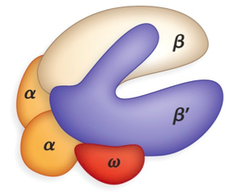
What structural differences exist between the core enzyme and haloenzyme of RNA polymerase?

answer
Core enzyme has 4 subunits: 2 α and β and β'. Haloenzyme has 5 subunits: 2 α, β, β' and a sigma subunit.
question
What is the purpose of the sigma subunit?
answer
The sigma subunit recognizes the -10 and -35 promoter sequences. Different sigma subunits exist to recognize different promoter sequences. When genes have better promoter sequences, they bind haloenzymes better and result in more transcription. For example, σ⁷⁰ is the housekeeping sigma σ⁵⁴ is for nitrogen metabolism σHS is for heat shock
question
True or False: Sigma factors are a transcription initiation factor in eukaryotes.
answer
False, sigma factors enable specific binding of RNA polymerase to gene promoters in prokaryotes.
question
What is a closed complex?
answer
RNA polymerase haloenzyme bound to promoter.
question
What is an open complex?
answer
Sigma subunit has left, RNA polymerase alone unwinds strands at the promoter.
question
Are primers required for RNA synthesis?
answer
No.
question
What four substrates are used in RNA synthesis? What kind of nonds are formed between these substrates? What is released when a bond is formed?
answer
ATP, CTP, GTP, UTP Phosphodiester bonds are formed. Pyrophosphate/diphosphate is released.
question
When does a sigma subunit fall off? And when does it bind to RNA polymerase again?
answer
Sigma subunit falls off 5-10 nucleotides after the promoter. It binds with RNA polymerase again when RNA polymerase reaches the terminator sequence and fall off.
question
True or False: The transcription bubble moves downstream with RNA ligase reannealing the template DNA behind.
answer
False, the DNA template needs to reanneal to its complementary strand, not single stranded RNA.
question
What are 2 methods of regulating how much of a certain gene is transcribed in prokaryotes?
answer
1. Strength of -10 and -35 sequences for binding to sigma subunits 2. Regulatory proteins such as activators and repressors
question
What does the Trp operon code for?
answer
5 enzymes involved in synthesis of tryptophan
question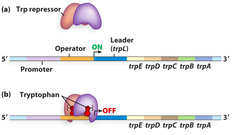
What is the mechanism of the tryptophan repressor?

answer
When low tryptophan, RNA polymerase is recruited to the tryptophan promoter in -10 and -35 sequences allowing for transcription. When high tryptophan, Trp repressor binds to tryptophan to be activated, and it binds to operator site within the tryptophan promoter and blocks transcription for anymore tryptophan.
question
How does the Trp Repressor binds to DNA?
answer
Trp repressor undergoes a conformational change when tryptophan binds to it which allows it to form a dimer with DNA. It makes base specific contacts with DNA using helix 5 of its helix turn helix motif.
question
How does binding of the Trp repressor and Tryptophan prevent RNA Polymerase from undergoing RNA synthesis?
answer
Binding of the repressor sterically inhibits access of RNA polymerase to the promoter. It specifically prevents the sigma subunit from locating the -10 and -35 sequences.
question
How many amino acids are in the Trp repressor?
answer
107 amino acids
question
Which of the following makes up the structure of the Trp repressor? a) two alpha subunits, and 4 alpha helices b) 3 alpha subunits, 3 alpha helices c) 4 alpha helices, and two beta subunits d) 6 alpha helices
answer
D: 6 alpha helices makes up the Trp repressor.
question
Is the lac operon subject to negative or positive regulation in E. Coli?
answer
Both.
question
What two signals are required for Lac operon to function?
answer
Absense of glucose Presence of lactose
question
Tryptophan is a _____ protein. CAP is an _________ protein.
answer
Repressor, Activator
question
What occurs in Lac operon during absence of glucose and presence of lactose?
answer
cAMP levels rise which binds to CAP causing a conformational change, and CAP drives the digestion of lactose. CAP binding site is upstream(5') of the -35 sequence and through direct protein-protein interactions it recruits RNA polymerase to the promoter. Allolactose binds to Lac Repressor which makes the repressor release from operator allowing for the transcription of LacZ which breaks down lactose into glucase and galactose. OPERON ON
question
What occurs in Lac operon during presence of glucose and absence of lactose?
answer
Low cAMP levels, CAP not activated and this RNA polymerase is not recruited. Lac repressor remains bound to promoter preventing transcription of LacZ. OPERON OFF
question
What occurs in Lac operon during presence of glucose and lactose?
answer
cAMP levels low, so CAP does not bind and does not recruit RNA polymerase. Presence of lactose cause Lac repressor to fall off. OPERON OFF
question
What occurs in Lac operon in absence of glucose and lactose?
answer
cAMP levels rise, CAP binds to its binding site upstream of the -35 sequence but it does not recruit RNA polymerase becuase the Lac Repressor remains bound to the promoter.
question
True or False: The Trp and Lac Repressors both bind at a promoter in between the -10 and -35 promoter sequences.
answer
False, the Lac repressor binds to a site downstream the -10 promoter sequence but the Trp repressor binds to the Trp promoter located in the -10 and -35 sequences.
question
What is responsible for positive regulation in Lac operon?
answer
Absence or presence of glucose
question
What is catabolite repression?
answer
When glucose is present, the expression for genes required for the metabolism of other carbon sources is limited.
question
True or False: When glucose levels are low, cAMP levels are also low.
answer
False, when glucose levels are low, cAMP levels are high.
question
What is the difference between RNA polymerase in eukaryotes versus prokaryotes?
answer
Prokaryotes have one type of RNA polymerase. Eukaryotes have 3 different RNA polymerases.
question
What are the three different RNA polymerases in eukaryotes and what is each used for?
answer
RNA poly I: rRNA RNA poly II: mRNA RNA poly III: tRNA and snRNA
question
What does it mean when gene transcription is "monocistronic" and where does this transcription occur?
answer
One gene = one promoter Monocistronic genes are found in eukaryotic cells.
question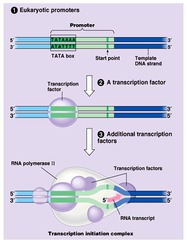
State the differences in the promoter region of eukaryotic and prokaryotic cells.

answer
Eukaryotic cells have a TATA box found upstream of the +1 transcriptional start site, they do not have -10 and -35 sequences nor do they have sigma subunits.
question
What complexes does RNA Polymerase require to bind to the promoter region in eukaryotic cells?
answer
TATA binding protein which is a compenent of the TFIID transcription factor.
question
What is the main difference in regulatory protein binding sites between prokaryotes and eukaryotes?
answer
Regulatory binding sites are generally way further upstream from promoter than in prokaryotics.
question
What 2 methods are used to change the structure of nucleosomes?
answer
1. Chromosomal remodelling complex 2. Enzymes such as histone acetyltransferases and histone deacetylases
question
True or False: RNA processing occurs at the same time as transcription
answer
True
question
State the 3 reasons why a 5'cap is required.
answer
Required for: 1. RNA export out of nucleus 2. Stabilizing the mRNA from being degraded 3. Acting as a Translation initiation signal
question
What is a polyA tail and how long is it?
answer
300 repetitive adenine bases added to 3' end of mRNA. PolyA tail is added after mRNA is cleaved after approximately 30 bases post the AAUAAA sequence. The polyA tail provides additional stability to mRNA and prevents it from being reduced by 3' exonucleases.
question
In what way does Trp repressors act as a "dimer"?
answer
Two monomers of the Trp repressor bind together creating a symmetric dimer structure which is required for inhibition of trypotophan promoter.
question
What is spliced out of mRNA to produce mature mRNA?
answer
Introns
question
What is "differential splicing"?
answer
Ability to put exons together in many different ways resulting in production of various proteins. This accounts for the large coding capacity of the genome.
question
What 3 sequences are required for splicing to occur?
answer
5' junction, branch point, 3' junction
question
What base is vital for splicing in the branch point?
answer
Adenine
question
What type of reactions occur when splicing out introns?
answer
2 Transesterification reactions
question
What is the first step of intron splicing?
answer
2'OH from adenine in branch point attacks 5' junction which releases the 5' junction from the intron. Lariat formed.
question
What is the second step of intron splicing?
answer
3'OH from 5' splice junction attacks phospjhatr group of 3' splice junction creating a bond and releasing the lariat structure.
question
What is a splicesosome/snRNP?
answer
snRNAs and additional proteins
question
What is the role of snRNPs: U1, U2, U4, U5, U6?
answer
U1 binds to 5' splice site U2 binds to lariat branch point Additional snRNPs are attracted to the splice site and they further excise the intron leaving the spliced mRNA behind.
question
In what way does RNA have catalytic potential?
answer
It can catalyze its own conversion to mRNA.
question
Where are snRNPs not required for pre-mRNA?
answer
In protozoa, mitochondria and chloroplasts
question
What is a key transcription factor responsible for positive regulationin yeast?
answer
Gal4
question
What is the UASgal?
answer
Upstream Activating Sequence - galactose which is a unit consisting of 4 sites on the Gal10 promoter which are bound to Gal4.
question
When is Gal4 active?
answer
In the presence of galactose
question
When galactose levels are low, how is GAL4 inhibited?
answer
By the repressor protein Gal80 which keeps Gal4 in its inactive state.
question
How does GAL4 become active in the presence of galactose?
answer
Galactose + Gal3 to Gal80, freeing Gal80 from Gal4 allowing to transcribe.
question
True or False: The GAL genes regulate transcription through protein-nucleic acid interactions
answer
False, the Gal genes interact through protein-protein interactions.
question
During catabolite repression, what transcription factor is responsible for the negative regulation of the GAL genes?
answer
Mig1 binds to Gal10 promoter region in presence of glucose inhibiting transcription.
question
How does Mig1 inhibit transcription?
answer
Mig1 recruits factors that modify chromatin in the vincinity of Gal10 to inhibit transcription
question
What happens to Mig1 when glucose is not present?
answer
It is phosphorylated and cannot enter the nucleus
question
Mig1 is used for _____ regulation of Gal genes. Gal4 is used for _____ regulation of Gal genes.
answer
Negative, Positive.
question
True or False: Gal4 does not alter chromatin structure
answer
False, Gal4 stimulates transcription by protein-protein interactions with components of transcriptional machinery and by altering chromatin structure.
question
What compenents allow for RNA export?
answer
5' 7-methylguanosine cap, 5' cap protein, exon junction complex, 3' PolyA tail, PolyA binding protein, proteins in nuclear membrane
question
What motif does Gal4 form?
answer
Zinc finger
question
Gal4 recruits RNA Polymerase ___.
answer
Gal4 recruits RNA Polymerase II.
question
Exons = expressed, Introns = ______.
answer
Interruptions
question
What comes first, the initiation proteins or primase?
answer
Initiation proteins
question
What is a "codon"?
answer
Three base sequence that codes for an amino acid or signal. Ex. AUG is the start codon
question
How many codons does the cell need?
answer
20 as there are 20 amino acids, but there are many more than that.
question
How many possible codons are there?
answer
4³ = 64 different codons because 4 different bases possible in one of the three different positions in a codon.
question
What does it mean when the genetic code is described as "universal"?
answer
The same codons coding for the same amino acids are found in all organisms, although there is codon bias in organisms.
question
What does it mean when the genetic code is described as "non-overlapping"?
answer
The codons are seperate and consecutive, non-overlapping.
question
Why does overlapping not occur in the genetic code?
answer
It would result in limitations in what amino acids could follow each other, becuase the last base of one codon would have to act as the first base for another.
question
Why did the genetic code evolve to not have any gaps?
answer
Gaps would cause the genetic code to be unnessarily long and complex by taking up space that serves no function.
question
How are gaps in the code removed?
answer
Splicing during mRNA processing
question
What is a "wobble" and where does it occur?
answer
Redundancy at one of the three bases in a codon still codes for the same protein, most frequently occurs at the 3rd position of the codon.
question
What does it mean when the genetic code is described as "commaless"?
answer
There are no gaps between codons, they are sequential.
question
Proteins/Amino acids that are needed more tend to have more _____ such that if a silent mutatuon occurs the needed protein can still be made because redundancy.
answer
Codons
question
Why do related amino acids have similar codons?
answer
Increased chance of a functional protein in the case of a single base mutation.
question
What is a missense mutation and what causes it?
answer
Difference in a single base that results in a different amino acid
question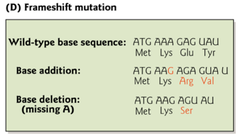
What is a frameshift mutation and what causes it?

answer
Insertion or deletion of bases resulting in an altered amino acid sequence past the site of mutation.
question
What sort of frame mutation is the least likely to impact the rest of the sequence?
answer
An insertion or deletion of exactly 3 bases.
question
What is a nonsense mutation?
answer
A type of missense mutation that results in a premature stop codon.
question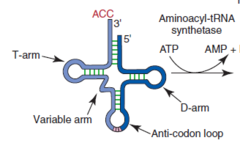
What is a common shape for all tRNA?

answer
Cloverleaf/Stem-loop structure
question
What are the two key regions of tRNA?
answer
- Anticodon - short single stranded region at 3' end with amino acid that matches codon
question
What is the sequence at the short single stranded region at the 3' end on tRNA that allows it to bind amino acid?
answer
CCA
question
What bond is formed between the acceptor site of tRNA and amino acids?
answer
High energy ester linkage formed between amino acid and tRNA by tRNA synthetase.
question
What is the shape of tRNA in 3D?
answer
L-shape
question
True or False: tRNA can base pair with more than one codon.
answer
True
question
What is required for a tRNA to bind to a codon?
answer
Antiparallel base pairs with at least 2 positions of the codon (Wobble).
question
What are the 2 functions of aminoacyl tRNA synthetase?
answer
1. Binds amino acid to tRNA 3' CCA site 2. Providing specificity by ensuring correct amino acids bind to correct tRNA anticodon
question
How many different aminoacyl tRNA synthases are found in the cell?
answer
20, one for each amino acid
question
What is the general structure of ribosomes?
answer
Large subunit: 49 proteins, 3 RNAs Small subunit: 33 proteins, 1 RNA
question
What are the 3 binding sites within a ribosome and what are their functions?
answer
A site, aminoacyl tRNA site. P site, peptidyl tRNA. E site, exit site.
question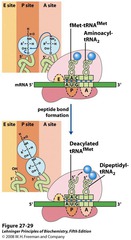
How many binding sites can be occupied at one time in a ribosome?

answer
2
question
In which direction does the ribosome decode the mRNA strand?
answer
5' to 3'
question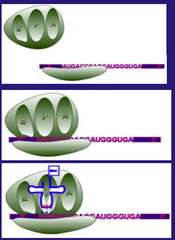
How is translation initiated in eukaryotes?

answer
- Intiator tRNA with methionine amino acid loaded onto small subunit with initiator factors - Loaded small subunit recognizes 5' cap and moves 5'-3' to find AUG codon - Inititaion factors dissociate, large subunit comes in and binds to small subunit - Initiator tRNA repositions to P site
question
How is translation initiated in prokaryotes?
answer
- Ribosomes recognize binding sequences upstream from each functional AUG - Prokaytic ribosomes readily bind to start codon - RNA-RNA base pairing allows for ribosome recognition
question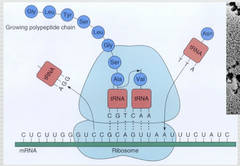
What is the second step of elongation in translation?

answer
Energy from the ester linkage of tRNA in P-site is used to link amino acid in A-site to amino acid in P-site
question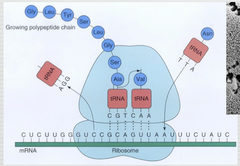
What is the first step of elongation in translation?

answer
Charged aminoacyl tRNA comes into the A site.
question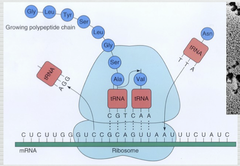
What is the third step of elongation in translation?

answer
Large subunit translocates forward (5'-3'), moving tRNA in P site → E site, and tRNA in A site → P site.
question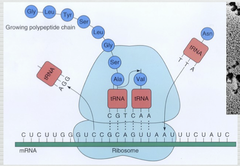
What is the fourth step of elongation in translation?

answer
Small subunit translocates forward (5'-3'), ejecting tRNA in E site. 1 tRNA still remains in P site.
question
What are the reasons why bacteria cannot initiate translation in the way eukaryotes do?
answer
Prokaryotes do not have a 5' cap and they have polycistronic genes unlike monocistronic genes in eukaryotes.
question
What is an "adenoma"?
answer
Benign tumour (can be surgically removed)
question
What is an "adenocarcinoma"?
answer
Malignant tumour (has spread elsewhere in the body)
question
What is "metastasis" and how many cancer cells survive it?
answer
Movement of cancer cells from one spot to other parts of the body. 1 in 1000 cancer cells survive metastasis.
question
What are the 3 steps of metastasis?
answer
1. Cancer Cells grow as benign on Basal Lamina 2. Cancer Cells pass through Basal Lamina into blood stream 3. Cancer Cells leave blood stream and make their way to a new tissue
question
How do we know Cancer is a genetic disease?
answer
Certain cancers are inheritable (Recall: Brca1, Brca2) DNA damage can cause cancer (UV light)
question
What are two preventable causes of cancer?
answer
Environmental cues (smoking, radiation) Viruses (HPV)
question
What percentage of cancer cases are linked to smoking? What percentage of lung cancer can be attributed to smoking?
answer
30%, 90%
question
What is the relationship between incidence of cancer vs age? Why so?
answer
Exponential chance of cancer as you age because over time you acquire more mutations within cells of your body.
question
True or False: Cancer is caused by a single mutation
answer
False, it takes an accumulation of mutations to lead to cancer (min. 10)
question
True or False: Cancer cell have an infinite lifespan
answer
True, they don't respond to signals that would stop cell division
question
What are the four properties of cancer cells?
answer
1. Immortal 2. Genetically Unstable 3. Can grow in abnormal places 4. Divide in absense of growth factors
question
How do cancer cells proceed through the cell cycle for division?
answer
They skip over all the checkpoints that would normally stop a defected cell from dividing.
question
What are 2 types on cancer causing genes?
answer
Oncogenes and Tumour supressor genes
question
What is an "oncogene"?
answer
Mutant form of a normal gene that experiences gain of function allowing it to act dominantly and cause cancer.
question
What is a "proto-oncogene"?
answer
Normal gene that can become an oncogene. (for instance, a mutation can cause it to divide rapidly)
question
What are the 3 types of genetic change that can lead to an oncogene?
answer
1) Sequence mutation leading to hyperactive protein made in normal amounts 2) Gene amplification 3) Chromosomal rearrangement of a gene in front of a very active promoter
question
What is a "tumour supressor gene"?
answer
A gene who's absence causes cancer
question
What is the most common tumour supressing gene?
answer
p53
question
Is apoptosis triggered in cancer cells?
answer
Nope.
question
What are the two nonspecific forms of treating cancer?
answer
Radiation and Chemotherapy
question
What is Gleevac and what does it treat?
answer
Treats Chronic Myeliod Leukemia It prevents the binding of Bcr-Adl by acting as a competitive inhibitor to ATP which is needed to bind the two. The binding od Bcr-Adl causes CML.
question
True or False: There is no tRNA for stop codons.
answer
True, a release factor comes in rather than a tRNA when a stop codon is reached.
question
Base stacking involves what types of bonds/interactions?
answer
Van der waals interactions
question
If a DNA polymerase lost its 3'-5' exonuclease activity, how would the mutant polymerase compare to the normal?
answer
To replicate the same amount of DNA, the mutant would hydrolyze fewer dNTPs than the normal polymerase.
question
Which protein is most amount at a replication fork?
answer
SSBP
question
(Transcriptional/Translational) control is a key step in bacterial gene expression.
answer
Translational control is a key step in bacterial gene expression, as transicriptional cannot be as controlled because of the prescence of operons.
question
Do bacteria have mitochondria?
answer
No, prokaryotes do not have mitochondria or chloroplasts.
question
What is a limitation on the use of PCR?
answer
The sequence at the beginning and end of the DNA to be amplified must be known.
question
Where do you want your restriction enzymes to cut to allow you to insert your cDNA into a plasmid and allow its expression?
answer
You want to cut at your start codon and past the stop codon to coporate both as they are essential for your ORF.
question
What is true about the expression of human proteins in bacteria?
answer
Protein can be produced in high abundance, can be easily purified, may be insoluble, can possibly be modified correctly.
question
How do you read a chain termination sequence based of gel electrophoresis?
answer
Bottom(5') to Top(3')
question
In a ribonucleoside, which sugar carbons are directly bonded to an oxygen?
answer
1', 2', 3', 4', 5'
question
If a chromosome within a cell has a lower degree of packing or is less ordered, what is the most likely explanation?
answer
Genes in that section are being actively expressed
question
How long are Okazaki fragments in humans?
answer
100-300 bp
question
What comes first, primase or initiator proteins?
answer
Initiator proteins
question
At a replication bubble how many leading and lagging strands are there?
answer
2 leading, 2 lagging
question
How many bases are replaced during normal mismatch repair, in humans?
answer
Varies, could be up to a couple hundred.
question
What interaction is required for the recruitment of RNA polymerase to the promoter in the inititaion of transcription?
answer
Protein to DNA interaction
question
Can RNA polymerase unwind DNA by itself? What about DNA polymerase?
answer
RNA polymerase can unwind the DNA strand, DNA polymerase requires DNA helicase.
question
Do the bases in the major groove look different than the bases in the minor groove in DNA from the point of view of a binding protein?
answer
Yes.
question
The nuclear membrane is an ______ structure with a _____ bilayer.
answer
Asymmetrical, bilayer
question
Does protein exit the nucleus?
answer
Yes.
question
What source of energy drives the coupling of tRNAs?
answer
Hydrolysis of ATP
question
What substrate is used to form peptide bonds in proteins?
answer
aminoacyl tRNAs
question
How does a ribosome select which aminoacyl is correct for the A site?
answer
Ribosome determines there is base pairing between the codon on mRNA and anticodon in tRNA.
question
In eukaryotes, approximately where is the ribosome binding site/SD box located?
answer
approx. 8 bases 5' to each AUG
question
Amount of staining of ethium bromide is ______ to mass.
answer
Proportional
question
What type of nucleic acid can be used to probe a Southern Blot?
answer
RNA or ssDNA
question
How can you remove RNA from an RNA-DNA duplex?
answer
Alkali or RNase H
question
Which sugar carbon are bases attached to?
answer
1'
question
It is diffifult to obtain DNA sequence beyond 700-800 bases, why?
answer
Lack of signal after this number of bases and resolution of bands is difficult.
question
True or False: In prokaryotes translational initiation requires a ribosome binding site just upstream the AUG codon, but not in eukaryotes?
answer
True
question
What do eukaryotes have in place of a ribosomal binding site for translation initiation?
answer
TATA box
question
To clone Your Favourite Gene, where would the two primers for PCR anneal?
answer
Directly at the start codon of the gene including the AUG codon and downstream the stop codon.
question
What property of the cells does ampicillin affect?
answer
Cell wall synthesis, unlike other antibiotics which typically inhibit translation.
question
How do you prevent plasmids from reannealing after they have been cut by restriction enzymes?
answer
Remove 5' phosphates from plasmid.
question
Can mutations be inserted through PCR?
answer
Yes, primers are error prone.
question
What is the first step of protein purification?
answer
Lyse the cell.
question
How are sequence gaps possible?
answer
Because we originally sequenced both ends of some clones
question
True or False: Cancer originates from a single cell.
answer
True
question
Formaldehyde and Benzene are found in cigarette smoke, what effect do they have on DNA?
answer
Formaldehyde denatures DNA/RNA Benzene is a strong mutagen
question
What activates and inactivates Gal4?
answer
Prescence of galactose
question
How is Gal4 activated?
answer
Gal3 binds Gal80 to remove Gal80 off Gal4, stimulating transcription of Gal10.
question
How does Gal4 stimulates transcription?
answer
Protein-protein interactions and alteration of chromatin structure.
question
What is the purpose of Mig1?
answer
Catabolite repression: glucose presence causes the limation of expression og gene required for other carbon sources.
question
How does Mig1 inhibit transcription of Gal1o?
answer
Mig1 binds to Gal1o promoter.
question
True or False: The phosphorylated form of Mig1 inhibits transcription.
answer
False, the phosphorylated form of Mig1 cannot get into the nucleus to inhibit transcription.
question
Gal80 is a _______ protein.
answer
repressor



